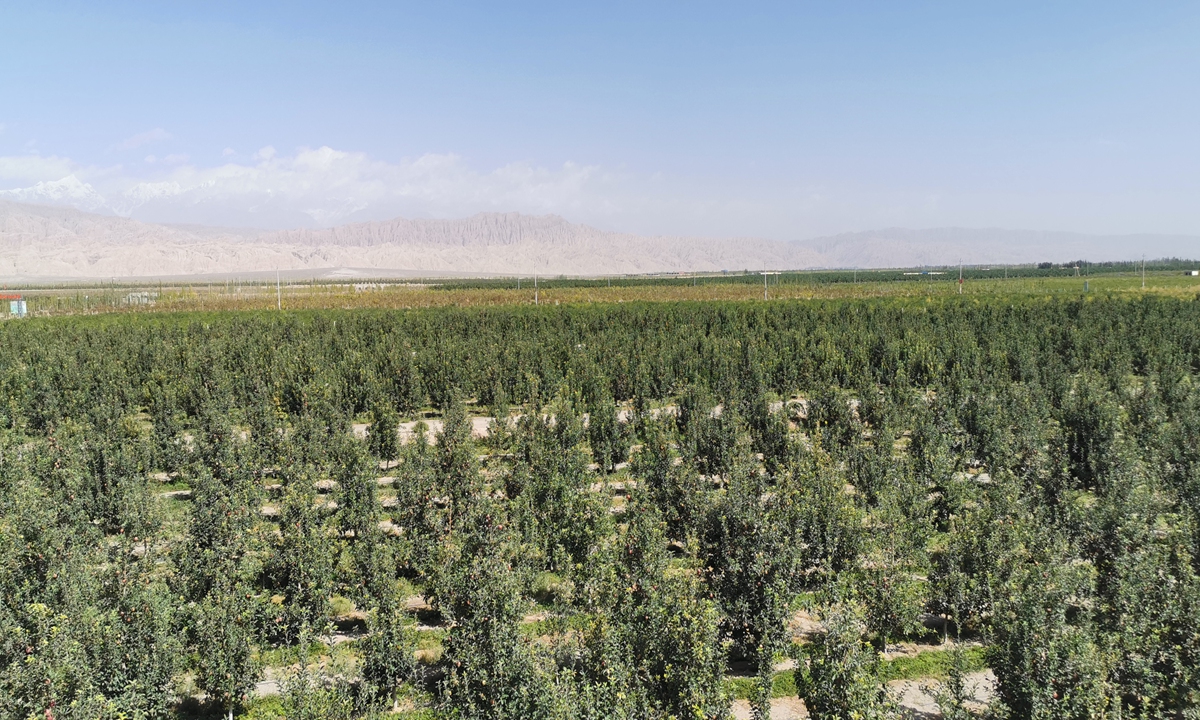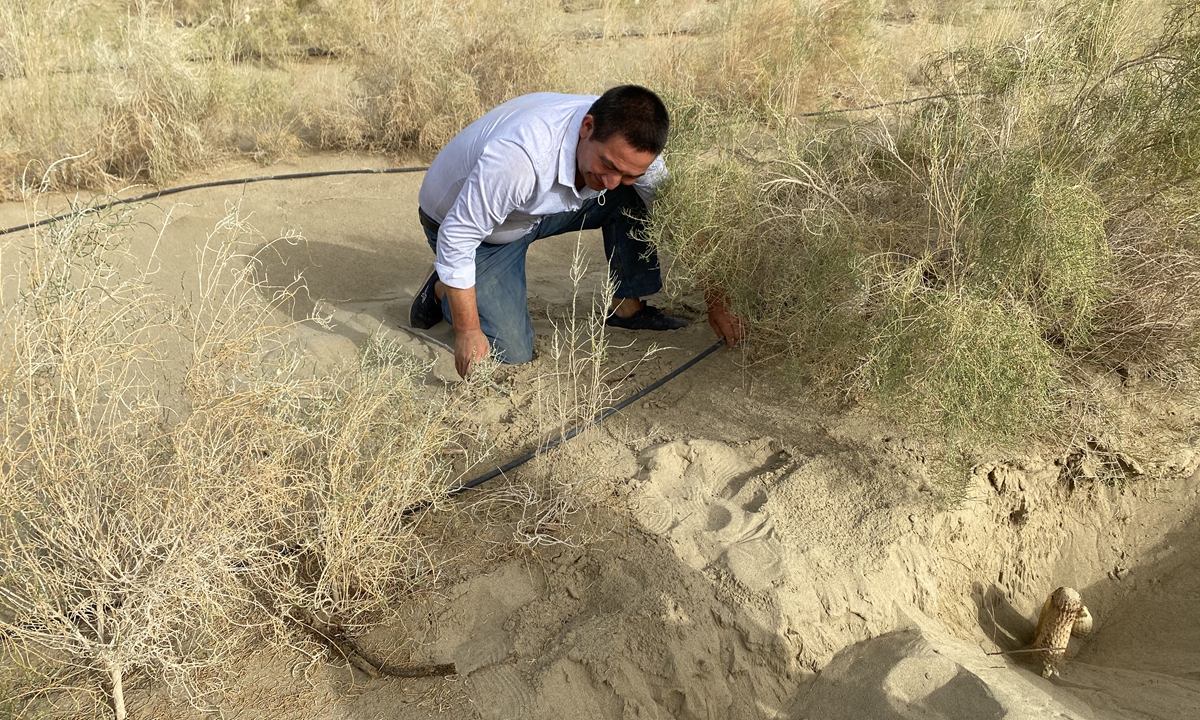Greening the desert
By Yu Jincui in Kashgar, Cao Siqi in Karamay and Hu Weijia in Aksu Source: Global Times Published: 2020/9/27 18:21:59
Xinjiang creates miracles in afforestation with unremitting efforts of local people

A view of the Kekeya Green Project, Aksu prefecture, Xinjiang, on September 10. Photo: Hu Weijia/GT
In Northwest China's Xinjiang Uygur Autonomous region, where desertification accounts for 43 percent of the region's land mass, local people have never stopped fighting against desertification. With China stepping up efforts in promoting ecological civilization, officials and people of all ethnic groups in Xinjiang have been carrying out large-scale afforestation and comprehensive treatment of desertified land, creating miracles one after another. The former desert has been gradually replaced by green forest and plantations of fruit trees. This has not only protected ecological environment, but also generated stable income for the poverty-stricken local residents.
A green garden
"Turning desert into oasis is the mission of Karamay people" is what almost every Karamay resident who the Global Times reporters met in the city said when recalling how their hometown was built in the Gobi desert and developed into a green garden.
It is probably the only city in China that has achieved the green coverage of 43 percent with the joint efforts from all its residents.
According to local residents, they have been planting trees for various reasons for years. For example, they would plant a tree as a symbol of love when they get married, and they would plant a tree to mark their solid friendships. Since 2016, newborns could get a seed of a tree with high economic value from a local eco-agriculture company. The children will cultivate the seed, nurture it and grow with the tree.
Previously, the city was characterized by drought, low rainfall, frequent high winds, harsh climate and serious land degradation. But now, with the completion of a water diversion project in 2000, the ecological environment of Karamay has been greatly improved.
Meanwhile, since 2001, the city started the project of planting trees and reducing emissions. So far, the green area has reached 148,000 mu with 48 million trees. That forms a green shield between the urban area of Karamay city and the Junggar Basin, effectively curbing the trend of land desertification, according to local authorities,
To further improve the ecological environment, the city initiated several projects such as "green project" and "desertification control" in 2012, which helped improve the green coverage from 33,000 mu in 2010 to 118,400 mu in 2019.

A forest ranger checks irrigation in the sand-fixing and windbreak forest of Makit county, Kashgar prefecture, Xinjiang, on September 12. Photo: Yu Jincui/GT
According to the data from the fifth national desertification monitoring, the severe and extremely severe desertification rate in Karamay account for 12.6 percent. When the city was built, it was 100 percent.From relying on camels and cars to pull water and using simple sewage treatment to plant trees to digging canals to divert water, Karamay has been exploring ways to realize ecological civilization for decades.
Fighting desertification
In 1986, a war against desertification was waged in Kekeya, an area in the northeastern suburbs of Aksu. Aksu, on the edge of the Taklamakan Desert - the largest desert in China, and also the world's second-largest shifting sand desert - used to get battered by sandstorms in over 100 days every year.
Li Zongming, head of the local Aerial Forest Protection Station, who has worked in Kekeya since 1988, recalled his memory about the sand and dust storms with the Global Times. "Once the sandstorms came, there was low visibility and we had to turn lights on during the day," Li said.
Over the past more than three decades, approximately 3.9 million person-time volunteers have planted trees in the Kekeya Green Project, building a great "green wall" stretching around 77,000 hectares between the desert and towns.
Li said that at the beginning, they could only plant trees like populus euphratica that are easy to survive in the sand. After the environment turned better, they began to expand the proportion of trees of economic value and attract social investments, managing to seek a balance between environmental protection and economic development.
Wu Xin, administrative officer of a local fruit plantation, said his company specializes in apple planting and processing started in 2016. The company could provide seasonal job opportunities, such as weeding and picking fruits, to about 40,000 local residents every year, paying them 150 yuan per day. Twenty-eight local residents from poor households work as permanent staff for the company and each could earn no less than 2,500 yuan per month.
Promoting development
"When we planned to start the project, some officials and farmers had doubts: How could trees be planted in desert where there is no population and grass?" said Yin Honghai, director of the sand-fixing and windbreak forest base in the Makit county, Kashgar prefecture. "But you see, through unremitting efforts of eight years, we have planted trees in an area of 370,000 mu," he said, pointing to a sea of forest.
The Makit county, located in the southwestern edge of the Taklimakan Desert, is surrounded by sand on three sides. The desert area accounts for 90 percent of the county's total area, "that means, we have only 10 percent living space. Afforestation is not only an issue of improving environment, but a life-and-death matter," said Yin.
Yin still remembers the horrible sandstorms he suffered when he first came to Makit in 2005. More than 150 days of a year were windy and sandy.
When there was sandstorm, rice-sized stone would hit crops, especially cotton, and badly damage them.
In 2012, the county launched a project that planned to plant 1 million mu of wind-proof and sand-fixing ecological forest. In this county with only a population of over 300,000, 20,000 to 30,000 people on average voluntarily participate in the tree planting during the spring and autumn planting seasons every year.
Yin said the number of sandy and dusty days has dropped to below 50 now and annual rainfall has increased from 53.6 mm in 2010 to 110 mm currently.
The project not only has helped improve ecological environment, but also promoted regional economic development and helped poverty reduction. Currently, a number of over 700 forest rangers are employed in the ecological forest base, all from poor households.
Abdumomun Emin, a ranger who has worked for eight years, said he now could earn 2,600 yuan per month. "Because of the hardships of doing this job, I wanted to give up in 2015, but now everything has turned better - the environment, work conditions and income - and I want to take care of the forest in the future, for myself and for the future generations," Abdumomun said.
Posted in: ECONOMY,BIZ FOCUS